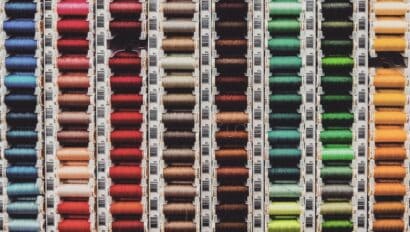Textile Exchange Releases Second Annual 2025 Sustainable Cotton Challenge Report
A catalyst to spur a shift in the market toward the use of more sustainable cotton.
Lubbock, Texas | June 3, 2020 at 11:00 AM EDT – The 2025 Sustainable Cotton Challenge (2025 Challenge) serves as a cornerstone for change in the apparel and textile industry by encouraging brands and retailers to commit to source 100 percent of their cotton from the most sustainable sources by the year 2025. This second annual 2025 Sustainable Cotton Challenge report includes information and statistics on the achievements and impacts that the initiatives in this program are having on water, communities, soil quality, biodiversity, and social considerations and regulations.
The Challenge was formed in 2017 when His Royal Highness The Prince of Wales convened a group of CEOs through the work of his International Sustainability Unit that existed to address critical challenges facing the world. Those original 13 CEOs committed to working together to accelerate the use of sustainable cotton, which paved the way for other industry leaders to follow – resulting in 82 companies now committed to sourcing 100 percent sustainable cotton by 2025.
The purpose of the 2025 Challenge is to increase the uptake of organic and preferred cotton, which has the ability to increase the income of smallholder farmers, eliminate highly hazardous pesticides, eliminate or reduce the amount of pesticides and synthetic fertilizer used, reduce water use and improve water quality and soil health.
Cara Smyth, Founder of the Sustainable Business Coalition said, “The resiliency of our long-term sourcing strategies starts on the farm. As the climate changes and we experience disruptions like COVID-19, we need to sustain the momentum of market share growth of preferred cotton to actively manage risk, enable end-to-end visibility and deliver value to investors, consumers, employees, and the planet.”
Today, 22 percent of the world’s cotton is more sustainable. By 2025, it is the vision of the 2025 Sustainable Cotton Challenge (2025 Challenge) that more than 50 percent of the world’s cotton is converted to more sustainable growing methods. One of the key focuses going forward will be to drive continuous improvement across the initiatives with a focus on best practices for soils. Implementing regenerative practices, which puts carbon back into the soil, is a key investment farmers can make to mitigate and reduce the climate crisis.
Brands and retailers joining the challenge and committing to source more sustainable cotton can choose from Textile Exchange’s list of recognized organic and sustainable cotton initiatives. These initiatives include:
- ABRAPA
- BASF e3
- Better Cotton Initiative (BCI)
- Cleaner Cotton
- Cotton made in Africa (CmiA)
- Fairtrade
- Fairtrade Organic
- Field to Market
- ISCC
- myBMP
- Organic Cotton
- Recycled Cotton
- REEL Cotton
- Regenerative Cotton
- Transitional Cotton
- United States Cotton Trust Protocol
By committing to using cotton from these initiatives and standards, the brands are ensuring that the intentions of their sustainable sourcing strategies are maintained and the integrity of their commitments uncompromised.
Zachary Angelini, Environmental Stewardship Manager at Timberland said, “We believe cotton can be sourced in a way that actually restores the environments it comes from and betters the lives of the people who grow it.”
Key Findings
Of the 82 2025 Sustainable Cotton Challenge signatories, 73 participated in the 2019 Corporate Fiber and Materials Benchmark program to report on their progress towards their goal of 100 percent cotton being sourced from the approved initiatives by 2025:
- 5% of 2025 Sustainable Cotton Challenge Signatories have achieved their 2025 target of 100% preferred cotton usage, all of which are organic.
- 5% have achieved a preferred cotton share of between 75-99%.
- 25% have achieved a preferred cotton share of between 50-74%.
- 15% have achieved a preferred cotton share of between 25-49%.
- 3% have achieved a preferred cotton share of less than 24%.
- 3% of their cotton is not being tracked yet.
From the niche to a market share of 22 percent, preferred cotton is gaining ground.
“The addition of U.S. Cotton Trust Protocol Cotton (USCTP) to the Preferred Fibers List will make it easier for 2025 Sustainable Cotton Challenge participants to achieve their goals, said Dr. Jesse Daystar, vice president and chief sustainability officer at Cotton Incorporated. “As the third-largest cotton producer in the world, the U.S. accounts for high volumes of responsibly-produced cotton. That cotton represents an ongoing commitment by generations of growers to reducing their environmental impact. Additional data provided by the USCTP offers a higher level of detail on modern cotton farming practices that many textile businesses want to more fully understand.”
“The tide is turning on traditional supply chains, with demands for greater transparency generating a change from transactional relationships to transformational partnerships,” said Alison Ward, CEO for CottonConnect. For sustainable cotton to become standard business practice, the amount of sustainable cotton grown and bought must increase significantly. The 2025 Sustainable Cotton Challenge sends a signal to millions of producers that there is a real demand for a more sustainable approach to cotton production that reduces the environmental and social costs.
Get more information and join the 2025 Sustainable Cotton Challenge today: https://textileexchange.org/2025-sustainable-cotton-challenge/.
Textile Exchange’s Role
In March 2018, the Prince’s International Sustainability Unit was closed and Textile Exchange became the initiative’s secretariat. Working under the guidance of a steering group with representatives from Marks & Spencer, Soil Association, Better Cotton Initiative, and Levi Strauss & Co., Textile Exchange continues to build on the momentum to secure a more sustainable cotton sector.
###
ABOUT TEXTILE EXCHANGE
Textile Exchange is a global nonprofit that creates leaders in the sustainable fiber and materials industry. The organization develops, manages, and promotes a suite of leading industry standards, as well as, collects and publishes vital industry data and insights that enable brands and retailers to measure, manage, and track their use of preferred fiber and materials.
With a strong membership that represents leading brands, retailers and suppliers, Textile Exchange has, for years, been positively impacting climate through accelerating the use of preferred fibers across the global textile industry and is now making it an imperative goal through its 2030 Strategy: Climate+. Under the Climate+ strategic direction, Textile Exchange will be the driving force for urgent climate action with a goal of 35-45% reduced CO2 emissions from textile fiber and material production by 2030.
To learn more about Textile Exchange, visit: TextileExchange.org. Follow us on Twitter at @TextileExchange.


